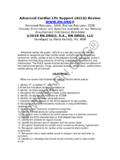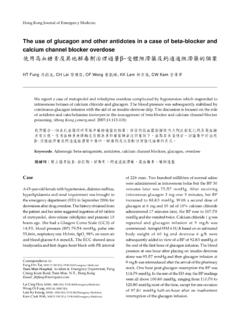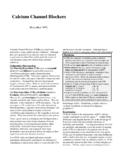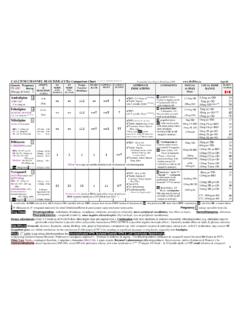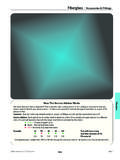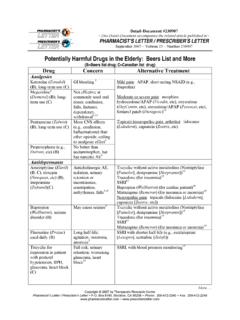Transcription of DBL CALCIUM GLUCONATE INJECTION BP - Medsafe
1 Version Page 1 of 9 NEW ZEALAND DATA SHEET 1. PRODUCT NAME DBL CALCIUM GLUCONATE INJECTION BP 2. QUALITATIVE AND QUANTITATIVE COMPOSITION DBL CALCIUM GLUCONATE INJECTION BP contains in each 10 mL, CALCIUM GLUCONATE BP 953 mg and CALCIUM Saccharate 30 mg. Each mL of the INJECTION contains mmol ( mEq), equivalent to mg of CALCIUM ions. DBL CALCIUM GLUCONATE INJECTION BP contains aluminium which is leached from the glass ampoules the product is packaged in. Aluminium levels of up to ppm have been reported for similar products. For the full list of excipients, see section 3. PHARMACEUTICAL FORM Solution for INJECTION . DBL CALCIUM GLUCONATE INJECTION BP is a clear, colourless solution . 4. CLINICAL PARTICULARS Therapeutic indications Parenteral administration of CALCIUM GLUCONATE is required in acute hypocalcaemia and hypocalcaemic tetany. It may be administered intravenously as an adjunct in the treatment of severe hyperkalaemia and as an aid in the treatment of depression due to overdosage of magnesium sulphate ( CALCIUM is the antagonist of magnesium toxicity).
2 Intravenous injections of CALCIUM have been used in the treatment of acute renal, biliary and intestinal colic. CALCIUM has been used as an inotrope in cardiac resuscitation. CALCIUM salts may also be used for the prevention of hypocalcaemia in exchange transfusions and in long term electrolyte replacement therapy. Dose and method of administration Dose CALCIUM GLUCONATE is usually administered intravenously as a 10% solution, by slow direct Version Page 2 of 9 intravenous INJECTION , or by continuous or intermittent intravenous infusion. Various maximum rates of administration have been recommended for direct intravenous INJECTION , including 2 mL/min, to 3 mL/min, and 5 mL/min. By intermittent infusion, a maximum rate of 2 mL/min ( mEq of CALCIUM ions/min) is suggested. During administration of CALCIUM , close monitoring of serum CALCIUM levels is essential.
3 CALCIUM GLUCONATE has also been given by intramuscular or, rarely, subcutaneous INJECTION to adults, but these routes are not recommended because of the possibility of tissue necrosis, sloughing, and abscess formation. Extravasation should also be avoided for this reason. Subcutaneous INJECTION and intramuscular INJECTION is contraindicated in children. Table of Equivalence of CALCIUM ions in DBL CALCIUM GLUCONATE INJECTION BP mmol mEq mg per mL per 10 mL 89 The dose of CALCIUM is dependent on the requirements of the individual patient. The usual initial dose for elevating serum CALCIUM is 7 to 14 mEq for adults. Doses may be repeated every one to three days if necessary. In hypocalcaemic tetany, doses of to 16 mEq may be administered until response occurs. The maximum daily dose should not exceed 15g of CALCIUM GLUCONATE ( mEq of CALCIUM ion).
4 For children and infants, initial doses of 1 to 7 mEq and less than 1 mEq respectively, are usually used to elevate serum CALCIUM . If needed, doses may be repeated every one to three days. For children with hypocalcaemic tetany, dosages of to mEq/kg, repeated every six to eight hours until response is seen, are recommended. Neonatal tetany may be treated with divided doses totalling about mEq/kg/day. CALCIUM salts may be administered intravenously in a dose of to mEq of CALCIUM as an adjunct in the treatment of severe hyperkalaemia, repeated as required under ECG control. For the treatment of hypermagnesemia in adults, an initial dose of 7 mEq may be given with subsequent doses adjusted according to response. In cardiac resuscitation, the recommended intravenous dose is 7-14 mEq for adults and mEq for children. CALCIUM salts may also be added to parenteral nutrition solutions for the prevention of hypocalcaemia.
5 Compatibilities It is recommended that DBL CALCIUM GLUCONATE INJECTION BP be diluted with either Sodium Chloride, 5% Glucose in Water, Lactated Ringers INJECTION , or 5% Glucose in sodium Chloride when intended to be administered as an intravenous infusion. It has been reported that at a concentration of - g/L, CALCIUM GLUCONATE is compatible in all of the infusion fluids listed above for 24 hours. To reduce microbiological contamination hazards, it is recommended that any further dilution Version Page 3 of 9 of the product should be effected immediately prior to use and infusion commenced as soon as practicable after preparation of the mixture. Infusion should be completed within 24 hours and any residue discarded. Any solutions which are discoloured, hazy or contain visible particulate matter should not be used. Supersaturated solutions of CALCIUM GLUCONATE are prone to precipitation.
6 Crystals may be redissolved by warming the ampoule to 80 C for 1 hour and shaking vigorously. Allow to cool to room temperature before dispensing. The solution should not be used if the precipitate remains after following the above procedures. The phenomenon of compatibility/incompatibility of CALCIUM salts with phosphates in solution is a very complex one and may be affected by solubility and concentration phenomena, pH, as well as temperature and time of storage of the admixture and the presence of other substances. Consequently, DBL CALCIUM GLUCONATE INJECTION BP should not be further diluted with phosphate-containing infusion fluids. Contraindications Aluminium can be leached from ampoule glass by CALCIUM GLUCONATE . In order to limit the exposure of patients to aluminium, especially those with impaired renal function and children (less than 18 years of age), DBL CALCIUM GLUCONATE INJECTION BP is not intended for use in the preparation of Total Parenteral Nutrition (TPN).
7 This product should not be used for repeated or prolonged treatment, including as an intravenous infusion, in children (less than 18 years of age) and those with impaired renal function, due to the risk of exposure to aluminium (See section ). CALCIUM GLUCONATE is contraindicated in patients with hypercalcaemia and hypercalciuria (eg hyperparathyroidism, vitamin D overdosage, decalcifying tumours such as plasmocytoma, bone metastases); severe renal disease; and CALCIUM loss due to immobilisation. The INJECTION of CALCIUM preparations is strictly contraindicated in the digitalised patients. CALCIUM enhances the effects of digitalis on the heart and may precipitate digitalis intoxication. Parenteral CALCIUM therapy is therefore contraindicated in patients receiving cardiac glycosides. Although no concrete evidence is available about the metabolic process leading from CALCIUM glucono-galacto- GLUCONATE to galactose, it is advisable not to administer CALCIUM GLUCONATE to galactosaemic patients.
8 Intravenous administration of CALCIUM is contraindicated when serum CALCIUM concentrations are above normal levels (ie - mEq/L). CALCIUM GLUCONATE should not be given by the intramuscular or subcutaneous route as necrosis or sloughing can occur. Special warnings and precautions for use CALCIUM GLUCONATE INJECTION contains aluminium (See section 2). This product should not be used for repeated or prolonged treatment in children younger than 18 years and in patients Version Page 4 of 9 with renal impairment due to potential increased risk of exposure to aluminium. Premature neonates requiring high doses of CALCIUM GLUCONATE are particularly at risk. Short term (acute) use of this product is not contraindicated in these patient populations. Aluminium might reach toxic levels with prolonged or repeated administration if renal function is impaired. Premature neonates are particularly at risk because they require large amounts of CALCIUM and their ability to eliminate aluminium from the body is reduced due to the immaturity of their kidneys.
9 Research indicates that patients with impaired kidney function, including premature neonates, who receive parenteral levels of aluminium at greater than 4 to 5 mcg/kg/day accumulate aluminium at levels associated with central nervous system and bone toxicity. Solutions of CALCIUM salts, particularly CALCIUM chloride, are irritant, and care should be taken to prevent extravasation during intravenous INJECTION . CALCIUM salts should be given cautiously to patients with impaired renal function, cardiac disease, or sarcoidosis. When used in large doses, serum CALCIUM concentrations and kidney function should be determined weekly or at the first sign of hypercalcaemia, which is characterised by symptoms such as anorexia, lassitude, muscular and joint pains, nausea and vomiting, thirst and polyuria. Frequent determinations of serum CALCIUM concentrations should be performed.
10 Hypercalcaemia is rarely produced by administrations of CALCIUM alone, but may occur when large doses are given to patients with chronic renal failure. Since hypercalcaemia may be more dangerous than hypocalcaemia, overtreatment of hypocalcaemia should be avoided. In mild hypercalciuria (exceeding 300 mg/ 24 hours) as well as in chronic renal failure, or when there is evidence of stone formation in the urinary tract, adequate checks must be kept on urinary CALCIUM excretion. If necessary the dosage should be reduced or CALCIUM therapy discontinued. In patients prone to formation of calculi in the urinary tract an increased fluid intake is recommended. ECG monitoring is required when CALCIUM is administered by intravenous INJECTION for treatment severe hyperkalaemia. CALCIUM GLUCONATE is a supersaturated solution. Do not use if a precipitate is present. Interaction with other medicines and other forms of interaction Cardiac Glycosides: The inotropic and toxic effects of cardiac glycosides and CALCIUM are synergistic and arrhythmias may occur if these drugs are given together (particularly when CALCIUM is given intravenously).











